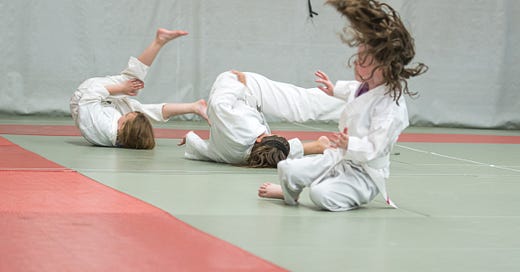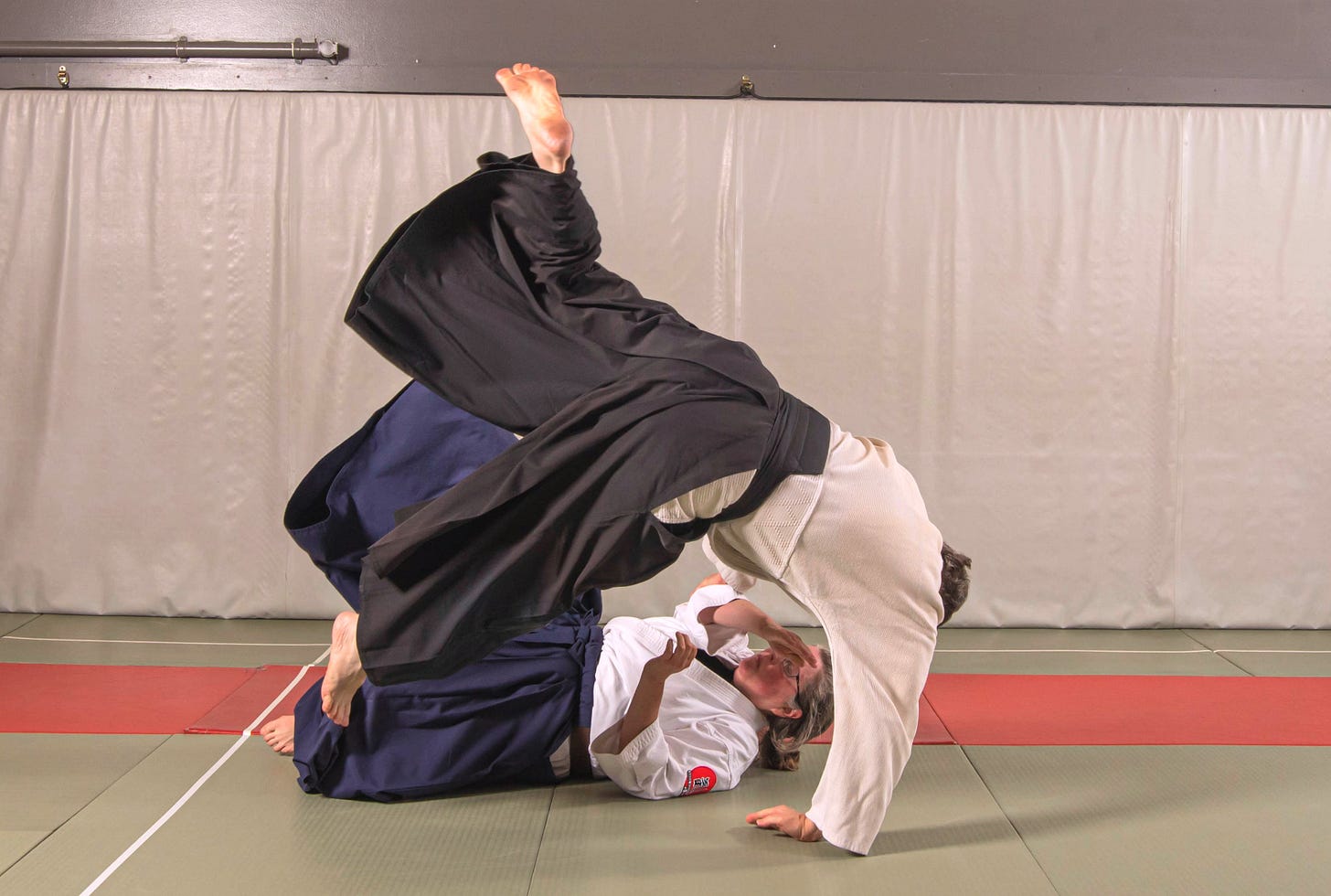After article Overcoming Dizziness in Aikido Rolls, Cheryl Whitelaw brings another ukemi inspiration from Feldenkrais method. Her insights and videos can bring new quality to the exercises that we already know and do. Enjoy:
Learning to respond as an uke is a substantial part of learning aikido. Rolling and taking ukemi requires both learning and applying skills in real-time interactions. In my experience learning ukemi is both fascinating and, often for beginners, frustrating.
In working with new students on learning to roll and take ukemi, I tend to work with 4 principles to support their learning. My goal in using principle-based teaching of ukemi skills is to support beginners to develop a felt sense of being connected with themselves, connected with the ground and ultimately connected with their partner.
Four Principles of Friendly Rolling
Agree with gravity
Come to the ground without “falling”
Expand rather than tighten
Learn to feel the floor as friendly
1. Agree with Gravity
When people start to learn rolling and ukemi, they tend to brace against the fall.
This is an early reflex we have as babies. It is a survival level reflex to brace when we feel a sense of falling. I have found that even accomplished uke can retain a small bracing reflex in their neck as they transition to roll or break fall.
So when teaching rolling, I support beginners to learn how to agree with gravity rather than resist falling. I will show later in this article some training forms I use to learn how to agree with gravity.
2. Come to the Ground without “Falling”
Beginners learning rolls and ukemi tend to fall to the ground at the end of the technique. This seems to make sense; nage affects uke’s balance so the natural consequence is to fall to the ground. I like to teach beginners about finding points of support as they come to the ground, so that they don’t “fall” but gradually “land” on the ground. Points of support can exist at points of contact with the ground and your partner. I find it helpful to teach beginners to find points of support as they perform ukemi.
3. Expand Rather than Tighten When Moving Towards the Ground
Beginners often tend to collapse their form during a roll, leaving their head, neck, shoulder and low back more vulnerable to hitting the ground. I work with beginners to learn how to expand as they move through a roll or while taking ukemi. Giving them a direction to expand outward works better than asking them not to collapse.
4. Learn to Feel the Floor as Friendly
The floor can feel unfamiliar when we first learn to roll. I work with beginners to start learning how to roll on the floor so they can become familiar with how the floor feels and how they perceive the floor as they roll across it. I also support them to develop a personal sensory map of pressure, stretch, weight and slide in response to the floor. I find once people develop their sensory capacity to perceive the floor and their movement in response to the floor, they are better able to sense their position relative to the floor. This work to create familiarity tends to reduce bracing and un-needed muscle tension as their nervous system and brain strives to keep them safe while falling.
Training Practices with 4 Principles
In this article I will explore two movement forms that I use to develop these 4 principles when teaching beginners how to roll.
Training Practice Form 1: Teddy Bear Roll
The first is a Teddy Bear Roll. I guide beginners to maximize their contact with the ground by sliding their hand blade along the ground as they tip to one side and roll across their backs to sit up on the other side. I cue them to let their weight act as a counter-balance so that as their arms and torso go toward the floor, their pelvic acts as a fulcrum that lifts their legs in the air.
I ask them to notice where they “fall” to the floor (meaning when they drop or hit the floor) and how they can minimize the moments of falling by expanding their shape to more fully meet the floor. I describe this as giving the floor a hug from the teddy bear shape. We may tend to think about ukemi as falling in aikido. I am pointing to a finer quality of coordination and relationship with gravity and the ground where as you move towards the ground, you stay dynamic and expansive as you meet the ground. In my experience this makes gravity a friendlier force and my coming to the ground more like a welcome embrace than a fall.
As they roll in this form, I ask them to pay attention to their shifting weight over their hip and pelvis and to notice the slide and pressure along the side of their arms, ribs and back. Paying attention to pressure, weight, stretch and slide helps these qualities become information they can listen to and learn about their movement.
Teddy Bear Roll - Variation 1 - Rolling from Sitting
Teddy Bear Roll - Variation 2 - Rolling from Kneeling
A next level version starts on the knees then slides to the side, across the back and returns to sitting on the knees.
Signs the Floor is Feeling Friendlier for Beginners
I look for signs that the floor is feeling friendlier for beginners, including that they are not:
Falling to the floor but moving over themselves and the floor smoothly and fluidly.
Lifting their chin and bracing their neck during the movement.
Holding their breath. I remind beginners to exhale as they move toward the ground. Holding breath is a clue that there is inner bracing happening.
I also look for signs that they enjoy the movement. To develop their inner sense of tracking the movement of their arms and legs, I give them cues to notice the trajectory of the outside edge of each foot, or the place where they roll over their pelvis so they learn to pay attention to themselves as they move.
Training Practice Form 2: Rolling Up from the Floor
The second movement form I use comes from an Awareness through Movement lesson taught by Moti Nativ, a Feldenkrais and Judo teacher.
This is a series of learning to roll from your back to come to sitting, kneeling and standing. I find that it helps beginners learn to coordinate themselves to roll from ground to standing. When they return to the floor from standing, I cue them to simply reverse the movements that brought them to standing.
I tend to guide this movement with a focus on their relationship with the floor - feeling the support, pressure, weight shift, sense of stretch and how they can find positions of support through the movement. I also cue them to agree with gravity by letting the weight of their limbs expand to the ground with gravity.
Depending on what I see, I may focus more on the principle of expanding while moving or agreeing with gravity, whatever I think will help them find that friendly feeling of the floor. I look for ways to move beyond retaining an un-needed amount of muscular contraction to make the movements. Once they have a feeling of that, I support them to apply these principles to different training forms including actual forward and backward rolls. I do find for beginners who are older and less supple in their movement, these training forms are essential stepping stones into rolling.
In a recent class, my sensei Brad Schultz led us through front and back rolling practice, applying this way of leveraging the support of the ground and expanding through the movement to generate enough uplift to bring us up on our feet. It is a delightful feeling to receive that uplift support from the ground, almost like rolling in an anti-gravity field so that I felt light, mobile and easeful. This is the quality I try to support beginners to find in their training - a sense of gravity and the ground as friendly.
We could talk about this approach to training as supporting beginners to find support from the ground and to open up their bodies to benefit from the upward lift of the ground force reaction. In rolling and ukemi, we are wired to notice when we lose our balance in the field of gravity. We notice the heaviness in our bodies as we fall and do what we must to protect ourselves against the ground.
In aikido, we can learn to benefit from the support of the ground to lighten and expand our movement as we make friends with gravity and the ground.
About the Author
Cheryl Whitelaw is a 1st dan black belt who volunteers in teaching children and adult Aikido classes at Abundant Peace Internal Martial Arts School, led by Brad Schultz Sensei in Edmonton, Canada.
Cheryl is a certified Feldenkrais practitioner, an Integral Master Coach™ and a Being in Movement Practitioner™, a method that combines Aikido and Feldenkrais to support people to regain their resourcefulness after experiencing trauma.
She is a functional movement specialist, supporting people to reclaim balance, mobility and power after life changing injuries and illnesses. She also works with aging athletes, particularly martial artists, to improve their performance at any age.
Her aikido practice focuses on the refinement of relationships with the environment, within her body and between mind and body to cultivate internal coherence, calm and power.
Cheryl also trains Tai Chi and Nei Gong.







Love your 4 principles and the relationship between feldenkrais and aikido so nicely explored. The back roll/teddy bear roll has been a favorite for awhile. Do you have any specific feldenkrais exercises that relate to front roll instruction?
Hi Cheryl -- thank you for sharing your insights and methods. Your work is truly a gift to the worldwide Aikido community!